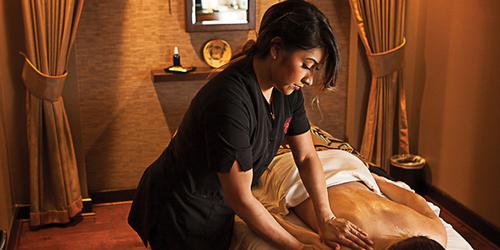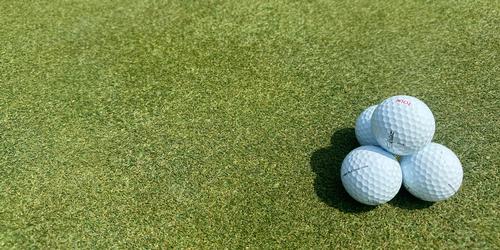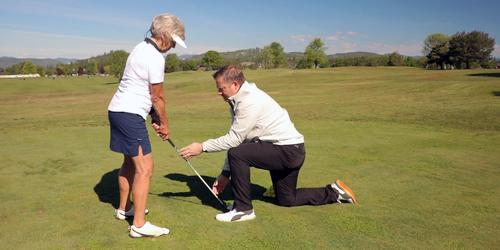Six Shots for Success - Part One
By Deb Turk

While watching golf on a Sunday afternoon, I marvel at the miraculous shots the Pros pull off. I have learned that they get into trouble just like we do. What makes them so good is their ability to get out of peril in one shot where we sometimes take three, four, or five. With this concept it mind, I thought it might be helpful to talk about Six Shots you must have in your bag to lower that handicap. By mastering them, you will see a dramatic effect on your overall score. Because there is so much to discuss, we will be offering this instruction in two parts. The text below will describe the chip shot, chipping with a hybrid, and finally the lob or flop shot. Next issue will feature the cut, the draw and the punch or knockdown shot.
I approached Kevin Geib, Director of Instruction at Eagle Ridge Resort & Spa in Galena, Ill. to share with us the techniques to properly execute these shots. He began his teaching career in 2003 and has been in his current capacity since 2006. Kevin is a PGA Class A Professional and is the first individual to attain the PGA Certified Professional in Instruction status in the State of Illinois. Kevin has contributed to local, state and regional publications in an effort to better the game. Most recently, Kevin became a contributing author to the book I'm not a Golfer, I Play Golf. I am pleased to bring you Kevin's written lessons which serve as the basis for this instruction.
To begin, reflect on the guiding principals in every golf shot - body alignment, shaft angle and ball position. In each shot presented below, we'll talk about the change up in these three elements as well as present other considerations in shot and club selection.
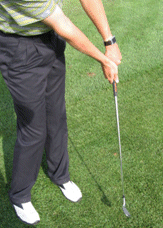
The Chip Shot
Where to use it: Around the green.
Why to use it: To keep the ball low and have it roll to the target.
Set-Up: Play the ball on the back foot, weight on the lead foot and tilt the shaft forward.
The Stroke: Once you've set your weight, ball and shaft position ask yourself, DO I or do I NOT involve my wrists? The answer is - it depends on how far you want the ball to go. If it's a very short chip shot, you're not going to have a whole lot of wrist action; if it's longer your wrists will break as they would naturally in your swing. You don't have to force any wrist hinge in this swing. When you come through the shot, you definitely don't want to flip your wrists. One of the biggest problem areas is the propensity for individuals to come through the golf ball and try to scoop the ball into the air by breaking their wrists too early. So, as you come through, you want to keep your hands ahead of the club and keep the shaft tilted behind your hands.
Club Selection: The size of the stroke you take will depend on the club used. Most use a pitching wedge but spend time playing around with club selection at the range. For example, a 7-iron is going to give you more roll, a sand wedge less. Depending on where you are in relation to pin placement, you may choose different clubs. Be creative. If you have a 60-70 yard chip shot, you may want to use a lower lofted club such as a 7 or 8 iron so you don't have to carry the ball as far. If the pin is closer to you, in a spot where you don't want to hit a flop or a pitch, take a lob or sand wedge, set up the same and land it a little further out, it's not going to roll as much and you'll still end up in a good spot. So play around with club selection when the pin is really far away or really close and you still want to hit that low running shot. You will gain more consistency if you pick one club to chip with versus changing it up around every green but it's important to become comfortable with other shots as you never know what the course will give you.
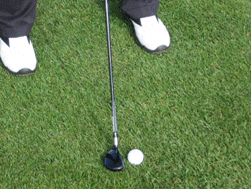
Chipping with a Hybrid
Where to use it: Around the green, from the apron or fairway leading up to the green.
Why to use it: It's difficult to guage how much a ball will slow down with 15 feet of fairway to go through on its way to the hole. It could die halfway there or skip right through the green. Using the hybrid in a putting stroke gives you 17- 25 degrees of loft versus a putter with 3-4 degrees of loft. The extra loft gets the ball a little into the air and allows it to hop through the fairway more than roll through it.
Set-Up: Take your putting stance. The ball position should be just front of center because the clubhead should be right in the center of your stance. Choke up on the club a little to feel more comfortable in the shot so you're not so far away from the ball. Use your typical putting grip.
The Stroke: When you make the stroke, there shouldn't be any wrist break or body turn at all, just a slight rocking of the shoulders as if you were making your putting stroke. Maintain the triangle between your arms and shoulders. Use the same length stroke as you would hit a putt for distance control.
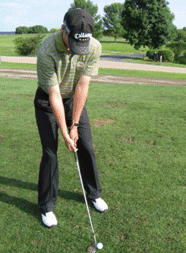
Flop or Lob Shot
Club Selection: Use the highest lofted club in your bag. A lob wedge will be easier to hit this shot with than a sand wedge.
Ball Position: Play it center or just slightly front of center. Be careful not to get the ball too far forward in your stance.
Weight Distribution: Slightly to the back foot like 55-45%.
The Shaft Tilt: You want the club to be vertical. If you tilt it back to add loft to the club, you're never going to hit the ball. You want to open up the club to add loft to it. The more you open it the higher the trajectory is going to be, the more the velocity it will have in a vertical fashion so the bigger the swing produces shorter results.
Opening the Club Face & Shot Alignment: When you set up to open the club, what you're going to do is twist the club- spin it open and then take your grip. Essentially, the open clubface position is now your square club in relation to your grip. So, set up square, turn the club open and then re-grip. From that stance, if we were to draw a line perpendicular to the groves of the club (for the right-handed golfer) you would see the clubface is pointed significantly right of your target and that will be the resulting shot if you don't compensate with your body and foot alignment. Open your body so that your feet are aimed left. The club should be aimed a little bit to the right of the swing path and the club face angle then should even out so that the ball ends up right in between where your feet are and where the club is.
Opening Your Body: The biggest problem with this shot is how players open up their body. With the body alignment, after they open up their club, they drop their left foot back. When you drop your left foot back, yes your foot alignment changes so that its not aimed left of the target, but you've also changed the ball position. If I were drawing a line toe to toe, that ball position is now all the way on my back foot and the ball on the back foot hits the ball low. So, now you've negated everything you are trying to do because the ball is back which is going to hit it low. You want to make sure that after you open the club and you want to open your body, you want to pivot around the golf ball. Keep the ball in the center of your stance and actually rotate yourself around the golf ball.
The Swing: To make this ball go anywhere you're going to have to make a very big swing because of how much loft and trajectory there is on this shot. If you miss it, even a little bit thin, this ball is going to go 100 yards instead of the 20-30 you wanted it to. Be sure to get under the ball.
Mastering these shots increases your ammunition when you step on the course. And, having these in your bag allows you to look at the course differently. Not every shot needs to be a high floater that might be pretty but not the most effective for the day's round. The above shots and the ones we'll discuss in the next issue require a lot of practice. But if you want to lower your handicap, you have to practice. The Pros have spent tireless hours playing around with ball position, weight and shaft angle which is why they pull off some miraculous recoveries. They understand the effects these three elements have on shot creation. Mastering them can really change your game.
Special thanks to Kevin Geib at Eagle Ridge Resort & Spa in Galena, IL. For more information or lesson offerings visit www.eagleridgeresortonline.com or call 815-777-5000.
Be sure to check our next issue to learn about the cut, the draw and the punch or knowdown shot.
Article Tags: Golf Chip Shot, Chipping with a Hybrid
Revised: 03/15/2009 - Article Viewed 31,557 Times
About: Deb Turk
![]() Deb Patton is the Women's Contributing Editor for Midwest Golfing Magazine. Her niche is writing unique stories that will help women enjoy the game at a higher level. Deb took up the game in 1992 and now plays to an 18 handicap. In fact, she shot 89 (her first round below 90) in 2008 at Erin Hills. She bested her career round by three strokes multiple times in 2009 and looks forward to breaking the 85 barrier in 2010. Besides golfing, Deb is an avid reader, culinary wiz, and also enjoys traveling.
Deb Patton is the Women's Contributing Editor for Midwest Golfing Magazine. Her niche is writing unique stories that will help women enjoy the game at a higher level. Deb took up the game in 1992 and now plays to an 18 handicap. In fact, she shot 89 (her first round below 90) in 2008 at Erin Hills. She bested her career round by three strokes multiple times in 2009 and looks forward to breaking the 85 barrier in 2010. Besides golfing, Deb is an avid reader, culinary wiz, and also enjoys traveling.
Contact Deb Turk:
GolfTrips.com - Contributing Editor




